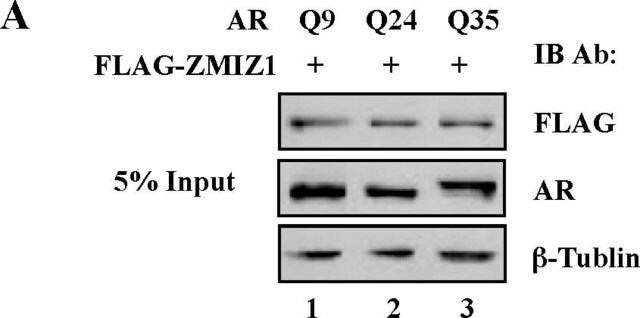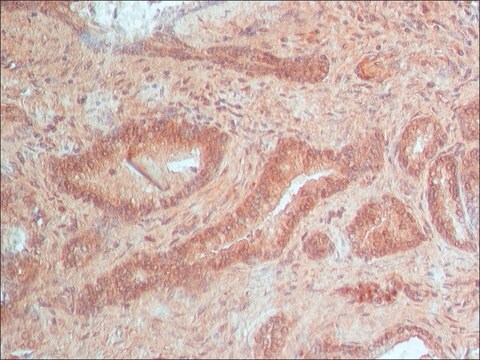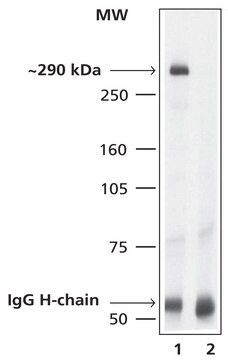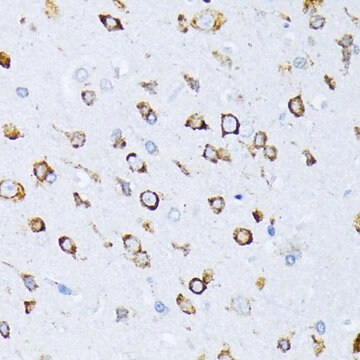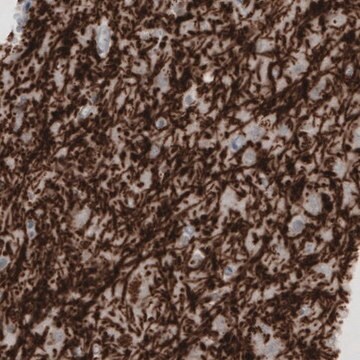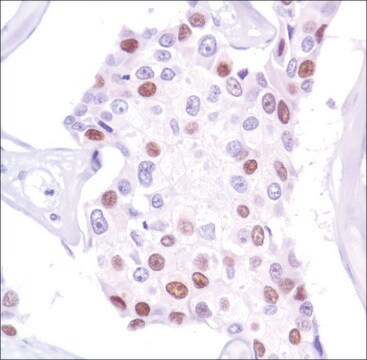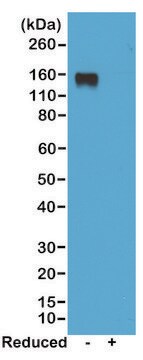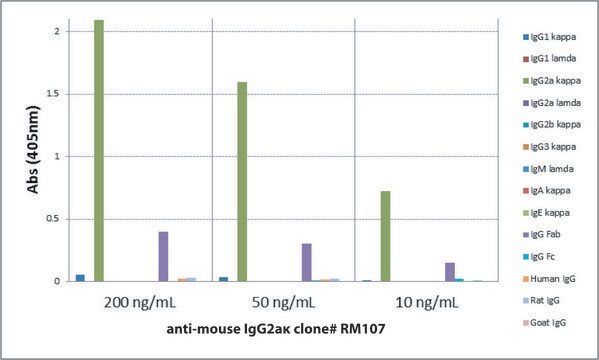SAB5500165
Anti-Progesterone Receptor antibody, Rabbit monoclonal
recombinant, expressed in proprietary host, clone SP2, tissue culture supernatant
Zaloguj sięWyświetlanie cen organizacyjnych i kontraktowych
About This Item
Kod UNSPSC:
12352203
NACRES:
NA.41
Polecane produkty
pochodzenie biologiczne
rabbit
Poziom jakości
rekombinowane
expressed in proprietary host
białko sprzężone
unconjugated
forma przeciwciała
tissue culture supernatant
rodzaj przeciwciała
primary antibodies
klon
SP2, monoclonal
reaktywność gatunkowa
human (tested)
reaktywność gatunkowa (przewidywana na podstawie homologii)
bovine, rabbit, pig
metody
immunohistochemistry: 1:400
izotyp
IgG
numer dostępu UniProt
Warunki transportu
wet ice
temp. przechowywania
2-8°C
docelowa modyfikacja potranslacyjna
unmodified
informacje o genach
human ... PGR(5241)
Opis ogólny
Receptor progesteronu (PgR) jest białkiem regulowanym przez estrogen. Zaproponowano, że ekspresja oznaczania PgR wskazuje na reagujący szlak receptora estrogenowego (ER). Wiele badań wykazało, że oznaczenie PgR dostarcza dodatkowych informacji do ER.
Receptor progesteronu (PGR) należy do rodziny receptorów hormonów steroidowych/tarczycowych czynników transkrypcyjnych aktywowanych ligandami. Posiada amino-końcowy region AF1, centralną domenę wiążącą DNA (DBD) i karboksylo-końcową domenę wiążącą ligand (LBD). Gen PGR jest zlokalizowany na ludzkim chromosomie 11q22.1.
Receptor progesteronu (PGR) należy do rodziny receptorów hormonów steroidowych/tarczycowych czynników transkrypcyjnych aktywowanych ligandami. Posiada amino-końcowy region AF1, centralną domenę wiążącą DNA (DBD) i karboksylo-końcową domenę wiążącą ligand (LBD). Gen PGR jest zlokalizowany na ludzkim chromosomie 11q22.1.
Immunogen
Rekombinowane białko kodujące aa 412-526 ludzkiego receptora progesteronu.
Działania biochem./fizjol.
Receptor progesteronu (PGR) działa jako czynnik transkrypcyjny,
który moduluje transkrypcję genów docelowych w odpowiedzi na progesteron i inne hormony. Jest fosforylowany w wielu miejscach, a czasami fosforylacja zmienia się w zależności od zaangażowanego hormonu. Podczas niedostępności hormonów PGR wiąże się z białkami szoku cieplnego. Kiedy ligand wiąże się, powoduje uwolnienie PGR z białek szoku cieplnego. Jest on następnie przenoszony do jądra, gdzie wiąże się z elementami odpowiedzi DNA (SRE) i składnikami maszynerii transkrypcyjnej. PGR wiąże się również z szablonami chromatyny i powoduje przebudowę chromatyny w sąsiedztwie miejsc wiążących PGR.
który moduluje transkrypcję genów docelowych w odpowiedzi na progesteron i inne hormony. Jest fosforylowany w wielu miejscach, a czasami fosforylacja zmienia się w zależności od zaangażowanego hormonu. Podczas niedostępności hormonów PGR wiąże się z białkami szoku cieplnego. Kiedy ligand wiąże się, powoduje uwolnienie PGR z białek szoku cieplnego. Jest on następnie przenoszony do jądra, gdzie wiąże się z elementami odpowiedzi DNA (SRE) i składnikami maszynerii transkrypcyjnej. PGR wiąże się również z szablonami chromatyny i powoduje przebudowę chromatyny w sąsiedztwie miejsc wiążących PGR.
Cechy i korzyści
Oceń nasze przeciwciała z pełnym spokojem. Jeśli przeciwciało nie sprawdzi się w danym zastosowaniu, zwrócimy pełną kwotę lub dostarczymy przeciwciało zastępcze. Dowiedz się więcej..
Postać fizyczna
0,1 ml króliczego przeciwciała monoklonalnego dostarczonego jako supernatant hodowli tkankowej w buforze TBS/1% BSA o pH 7,5 z dodatkiem mniej niż 0,1% azydku sodu.
Oświadczenie o zrzeczeniu się odpowiedzialności
O ile nie określono inaczej w naszym katalogu lub innej dokumentacji firmy dołączonej do produktu(-ów), nasze produkty są przeznaczone wyłącznie do użytku badawczego i nie mogą być wykorzystywane do żadnych innych celów, w tym między innymi do nieautoryzowanych zastosowań komercyjnych, zastosowań diagnostycznych in vitro, zastosowań terapeutycznych ex vivo lub in vivo lub jakiegokolwiek rodzaju konsumpcji lub zastosowania u ludzi lub zwierząt.
Ta strona może zawierać tekst przetłumaczony maszynowo.
Nie możesz znaleźć właściwego produktu?
Wypróbuj nasz Narzędzie selektora produktów.
Kod klasy składowania
10 - Combustible liquids
Klasa zagrożenia wodnego (WGK)
WGK 2
Temperatura zapłonu (°F)
Not applicable
Temperatura zapłonu (°C)
Not applicable
Wybierz jedną z najnowszych wersji:
Masz już ten produkt?
Dokumenty związane z niedawno zakupionymi produktami zostały zamieszczone w Bibliotece dokumentów.
Jake J Reske et al.
Human molecular genetics, 29(20), 3412-3430 (2020-10-20)
Although ARID1A mutations are a hallmark feature, mutations in other SWI/SNF (SWItch/Sucrose Non-Fermentable) chromatin remodeling subunits are also observed in endometrial neoplasms. Here, we interrogated the roles of Brahma/SWI2-related gene 1 (BRG1, SMARCA4), the SWI/SNF catalytic subunit, in the endometrial
Steroid receptor coactivator-1 (SRC-1) enhances ligand-dependent and receptor-dependent cell-free transcription of chromatin.
Liu Z, et al.
Proceedings of the National Academy of Sciences of the USA, 96(17), 9485-9490 (1999)
Olivia Jeong et al.
International journal of molecular sciences, 23(23) (2022-12-12)
Women with complex atypical hyperplasia (CAH) or early-stage endometrioid endometrial cancer (EEC) are candidates for fertility preservation. The most common approach is progesterone (P4) therapy and deferral of hysterectomy until after completion of childbearing. However, P4 therapy response rates vary
Phosphorylation of human progesterone receptor by cyclin-dependent kinase 2 on three sites that are authentic basal phosphorylation sites in vivo.
Zhang Y, et al.
Molecular Endocrinology, 11(6), 823-832 (1997)
Phosphorylation of human progesterone receptor by cyclin-dependent kinase 2 on three sites that are authentic basal phosphorylation sites in vivo.
Y Zhang
Molecular Endocrinology, 11(6), 823-832 (1997)
Nasz zespół naukowców ma doświadczenie we wszystkich obszarach badań, w tym w naukach przyrodniczych, materiałoznawstwie, syntezie chemicznej, chromatografii, analityce i wielu innych dziedzinach.
Skontaktuj się z zespołem ds. pomocy technicznej